How a commander’s defection led to a genocide in Sudan

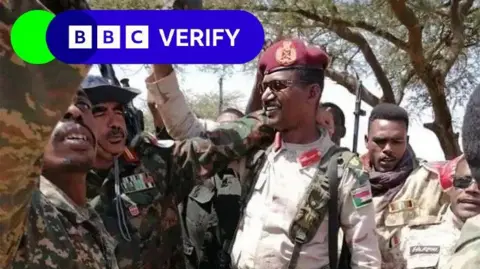 social media
social mediaAnalysis of those videos by BBC Verify showed fighters claiming genocide and later mocking survivors. Those responsible have apparently been identified as Sudan’s paramilitary Rapid Support Force (RSF).
The BBC has confirmed that at least 80 people were killed in the October attack on al-Seriha in Gezira state, with the United Nations reporting that the death toll could be as high as 124. A witness told BBC Verify that he saw unarmed civilians being shot as the fighters came too close as they tried to flee.
The massacre appears to have been caused by a senior RSF commander in Gezira state joining the country’s armed forces.
In a statement to the BBC, an RSF spokesperson denied that its fighters were involved in killings and said that “Rapid Support Forces operate to protect civilians and promote security and peace, not To target them.”
A brutal, 20-month power struggle that rivaled Sudan. Military officers against their former RSF colleaguesWidespread atrocities committed by both sides have been condemned by human rights groups.
WARNING: This story contains detailed descriptions of murders and photographs of dead bodies, which some readers may find disturbing.
How a defection led to retaliatory attacks
On 20 October, the Sudanese army announced that Abu Kekal, a senior RSF commander in Gezira state, had been killed. had defected with them With his large army.
Kikal’s decision to return to the Sudanese Army, where he had served before the war, was hailed as a major propaganda success, and other RSF soldiers were urged to do the same as part of a wider amnesty offer. Was.
Shortly after Kikal’s defection, fighters carried out at least 69 retaliatory attacks on towns and villages in Gezira state between 20 October and 4 November, according to data recorded by the war monitoring organization Armed Conflict Location and Event Data (ACLED). Started a series.
BBC Verify has investigated one of these attacks in detail, using eyewitness testimony, satellite imagery, video footage and photographs to understand what happened.
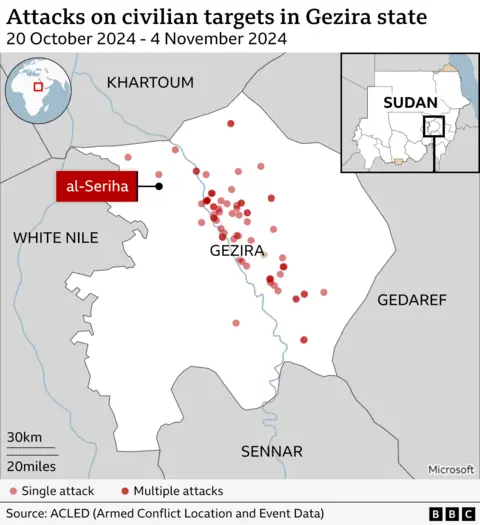
How the massacre happened in Al-Seriha
Mohammed Ismail was attending morning prayers at a local mosque on October 25 when he heard fighters approaching the outskirts of al-Seriha, a town of about 15,000 people, 90 km (60 miles) south of the Sudanese capital Khartoum.
He told the BBC that when violence spread all around, he ran home to save his family.
Gunmen had climbed a mosque and were firing at “whatever was going on” below, he said.
Many people were shot while trying to escape, he said. Others were shot at close range in the fields surrounding the town. Many of his family members were among the dead.
criminals are being identified
BBC Verify has obtained a series of videos filmed by the fighters themselves, in which they boast about their actions and ask Keikal, a former RSF commander, to see for himself what they are doing to the people of his area. Are.
In one, soldiers wearing RSF insignia are seen celebrating their attack on the town and the killing of locals. The circular insignia visible on his right shoulder, which also appears in some other clips, consists of a black outline, a curved representation of the Sudanese flag and a round logo above it – the symbol used by the RSF.
We confirmed that the video was filmed in Al-Seriha by comparing the buildings and other elements within the video with satellite imagery of the city.
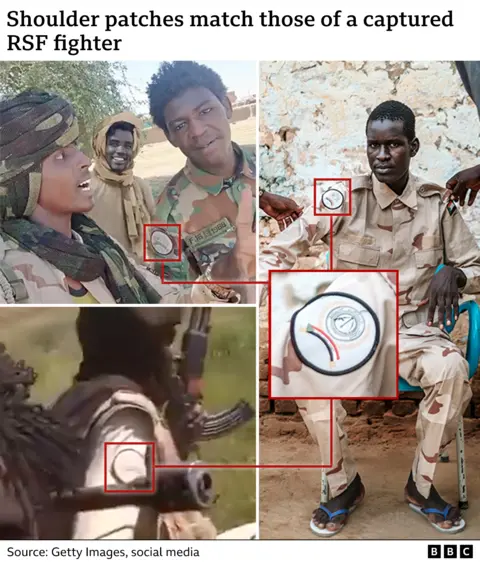
In one video, a fighter shows his wristwatch to the camera, which shows the date October 25 – and repeats out loud – the date of the massacre in al-Seriha.
Mr Ismail also told the BBC that when he arrived in the town, he recognized some of the fighters involved in the attack as former residents who had signed up to fight with the RSF.
He also said he saw two commanders in the area who are believed to be senior RSF leaders. BBC Verify put photographs of some RSF fighters through facial recognition software in an attempt to identify the individuals, but these searches returned no matches.
The soldiers left the locals in no doubt that the massacre was in response to Kikal’s defection.
In one video, a guard says in Arabic: “Keikal…look, these are your people.”
We were able to match the shapes of landmarks seen in this video, such as trees and nearby buildings, to satellite images of Al-Seriha.
In another video – which could not be geolocated but first appeared online on 26 October – men dressed in military fatigues with RSF insignia talk about Keikal’s defection and refer to “traitors” in the state of Gezira. Are. He specifically mentioned Al-Seriha and said that the city will get what it deserves.
At several points in the video, they refer to themselves using the Arabic word “Ashawis” meaning “brave”, a term used by RSF fighters to identify themselves.
When BBC Verify contacted the RSF for comment, they denied that the people in the clip were their soldiers. A spokesperson for the group said, “You can easily obtain a Rapid Support Forces uniform and wear it… then commit crimes against civilians, criminalizing the Rapid Support Forces.”
Although it is not possible to rule it out, the BBC has seen three separate videos filmed by the fighters themselves, in which RSF insignia can be seen on the uniforms of those involved.
A report by Human Rights Watch In attacks on al-Sehira and other towns in Gezira state since Keikal’s defection on 20 October, the RSF were identified as the perpetrators.
On October 29, The United Nations issued a statement The killings in al-Seriha and other towns in Gezira State were condemned and RSF was held responsible for these attacks.
How many civilians were killed?
The BBC has obtained four separate videos of the aftermath of the attack on al-Seriha. They are very graphic and show bodies covered with shrouds and blankets in the courtyard of a mosque. Early versions of these videos appeared online on 26 October.
BBC Verify has established that the image below was taken by matching key features, including the steel gate in the mosque’s courtyard and a satellite dish in the background, to an image of the mosque from Google Maps.
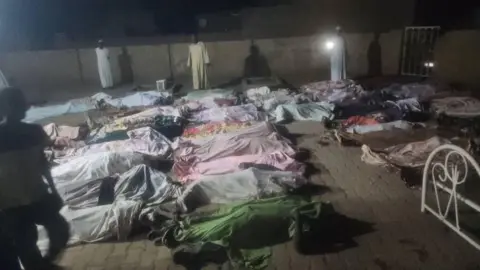 social media
social mediaBBC Verify studied video and photographic evidence, counting at least 82 bodies lying in beds or on the floor.
The United Nations said 124 people were killed in reprisal killings in al-Seriha. Gezira Congress, a local civil society group, says the figure could be as high as 140.
Another piece of evidence uncovered by the BBC Verify investigation is the presence of freshly dug mounds of earth in the city’s cemetery.
Mr Ismail told us that a mass grave had been dug in the cemetery.
These mounds can be seen in a previously unused part of the cemetery in satellite photos taken after the attack. These are not present in the satellite photos taken in May.
Nathaniel Raymond, executive director of Yale’s Humanitarian Research Lab, told the BBC that in a separate image taken on October 30, the graves appear to have been recently dug, given the distinctive shape of the mound and the color of the surrounding earth. In the graphic above, we have shown a satellite image from December 6 that shows the cemetery more clearly.
“These two indicators tell us that the mounds may not have been there for more than a few days because over time the edges of the mounds will become smoother and more blurred due to wind and dust,” he said.
Although the BBC cannot confirm how many people may be buried in the new part of the cemetery, the size of the mound of earth measured in front of a nearby white building suggests that many bodies may have been buried there.
The survivors were held for ransom
Once the initial firing ended and the troops took control of the town, the survivors were rounded up and taken into custody.
BBC Verify has obtained videos of these detentions and kidnappings.
In one, at least 60 people can be seen sitting or standing in front of a wall, watched over by armed fighters.
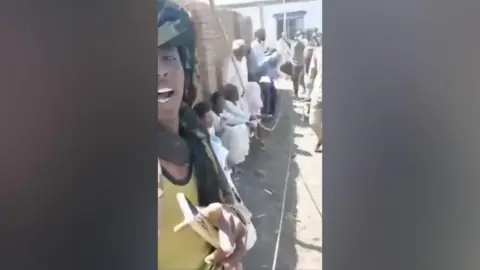 social media
social mediaSome of the detainees appear to be elderly, and many are wearing white clothes stained with blood.
At one point in the video, the fighters taunt their captives, calling them dogs and making animal noises.
“Say baa, dog, say baa, say baa. You dare take up arms again, don’t mess with the Rapid Support Forces.”
BBC Verify confirmed that it was filmed in the north-western part of the city by matching specific features shown on satellite maps. In particular, there appears to be a corrugated iron structure that can also be seen in satellite imagery taken on October 30.
Rest of the people are seen walking in a line with their hands raised. The footage later shows the fighters mocking their captives, with residents forced to make animal noises while the fighters laugh and watch.
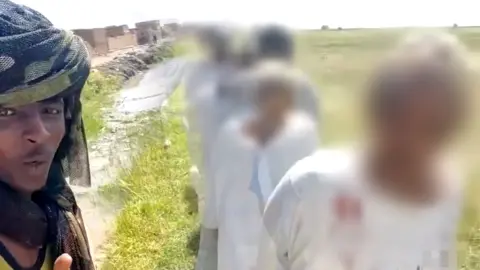 social media
social mediaLater another group of men passed by the fighters with their hands behind their backs.
As the group moves on, a fighter recognizable from the earlier clip again mocks the people.
“Did we defeat al-Seriha,” the fighter asks the captives, before repeatedly saying: “Did we do well?”
Elmubir Mahmoud, secretary-general of the Gezira Congress, told the BBC that the fighters took 150 hostages with them after abandoning the town. He said at least 11 detainees – including a three-year-old girl – have been killed so far. BBC Verify cannot confirm this.
But testimony given to us by city resident Mohammed Ismail shows that survivors were forced to pay ransom for the release of their family members. He said the hostage-takers had demanded between US$100 and US$1,000.
The activities of the RSF and the Sudanese army in the state of Gezira have drawn international condemnation, with the United Nations and human rights groups expressing outrage.
US Ambassador to the UN Linda Thomas-Greenfield in a statement urged countries to stop providing arms to both sides of the war. He said supplies were prolonging the conflict.
“The people of Sudan have gone through hell,” he said. “They deserve protection, respect and justice. They deserve to live.”
Additional reporting by Mohanad Hashim. Graphics by Mesut Ersoz.







